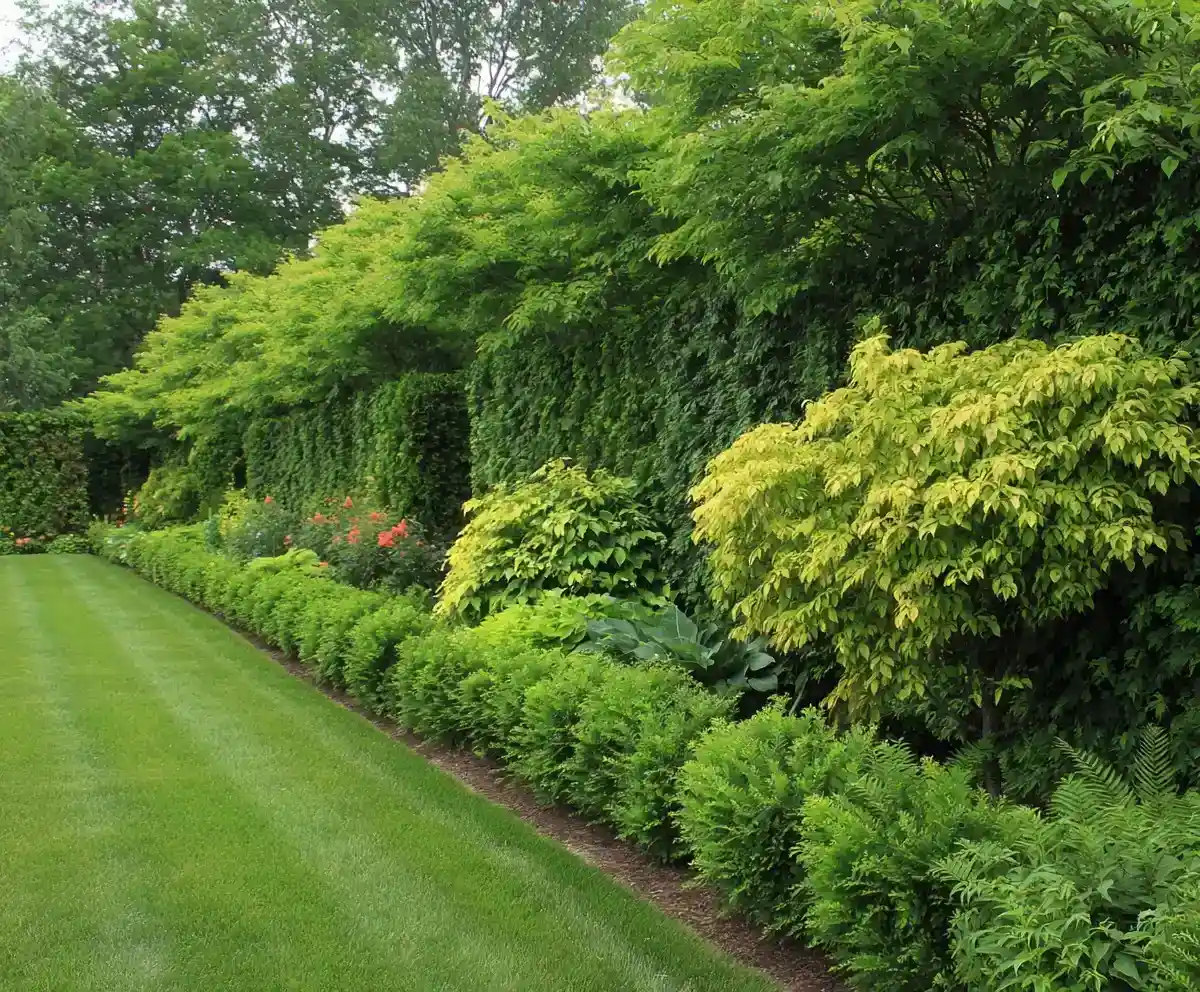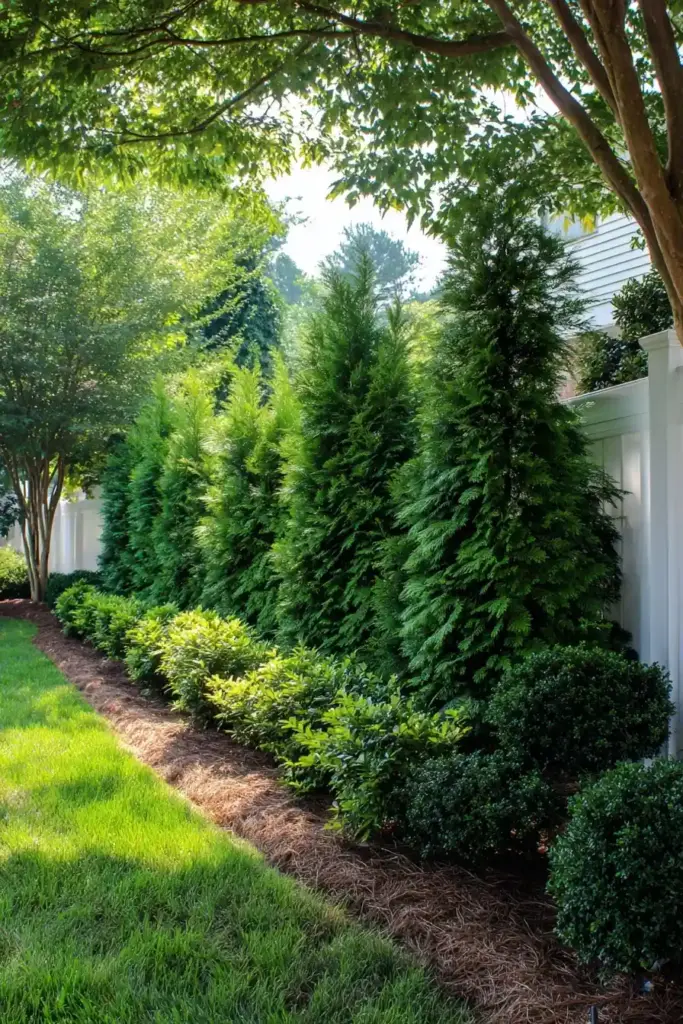Looking to add some green seclusion to your outdoor space? Privacy trees along a fence are one of the most natural and attractive ways to create a living wall that offers beauty, shade, and solitude. Whether you’re hoping to block out nosy neighbors, create a backyard privacy screen, or soften a harsh fence line, privacy trees can do it all—while enhancing the overall landscape design of your yard.
But before you start planting, it’s important to consider a few key factors. The root systems of privacy trees can be extensive, so choosing species that won’t damage nearby foundations is crucial. Sunlight availability, spacing for mature width, and maintenance needs (like pruning and watering) all play a part in creating a sustainable and beautiful screen. The good news? With thoughtful planning and the right mix of trees and companion plants like drought-tolerant varieties, you can turn an ordinary fence line into a lush, functional, and elegant boundary.
In this guide, we’ll walk you through 15 inspiring ways to use privacy trees along a fence, from classic evergreens to mixed-species plantings and creative landscaping touches like gravel beds, tree benches, and underplanting. Let’s dive in!
Table of Contents
1. Layered Evergreen Hedge
When it comes to privacy landscaping along a fence, you can’t go wrong with a layered evergreen hedge. These dense, year-round trees provide excellent screening while creating a soft, natural border that feels more like a garden feature than a barrier. The trick lies in using a mix of evergreen varieties to create depth and texture.
Start with a back row of taller privacy trees like Thuja Green Giant, Leyland Cypress, or Eastern Red Cedar, which grow quickly and offer dense coverage. In front of these, plant medium-height shrubs like boxwood, dwarf yew, or holly to create a second tier. You can even add low-growing evergreen groundcovers, such as juniper or creeping phlox, at the base to finish the look.
Why it Works:
- Offers dense, year-round screening
- Layering adds visual interest and prevents a “wall-like” feel
- Provides habitat for birds and beneficial insects
Tips for Success:
- Space trees properly to avoid overcrowding as they mature
- Water consistently in the first 2–3 years for deep root development
- Use a mulch bed beneath for moisture retention and weed suppression
This approach not only boosts curb appeal but also makes your fence line feel more like a living landscape than a rigid barrier.
2. Mixed Privacy Tree Border
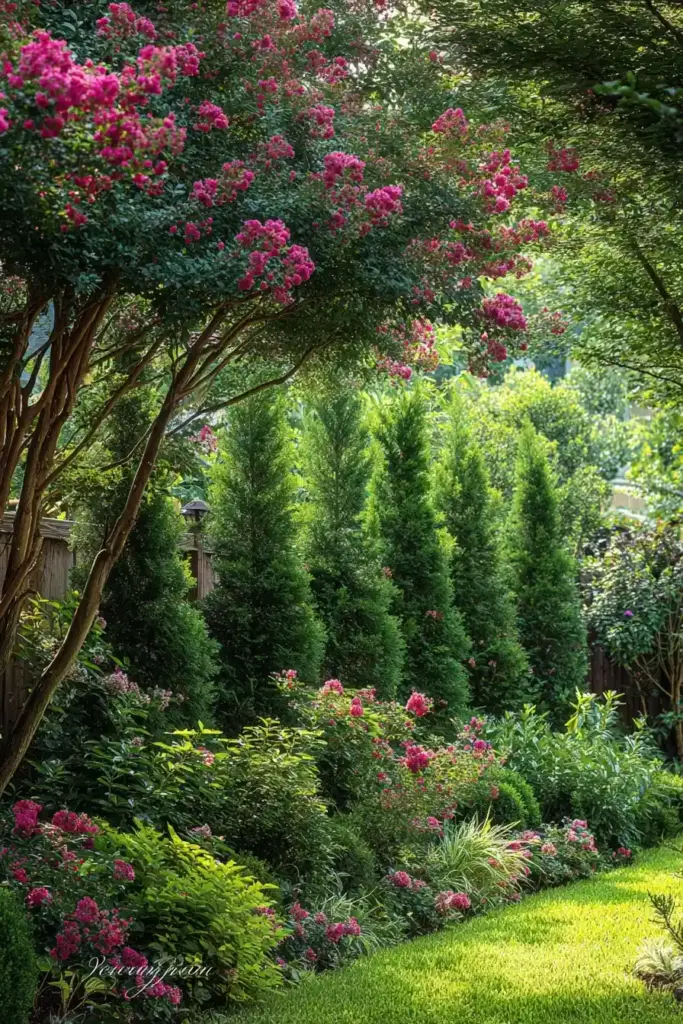
If you want a privacy solution that offers more than just green foliage, consider a mixed privacy tree border. This landscaping idea combines evergreen trees for year-round screening with seasonal flowering or deciduous trees to add bursts of color, texture, and movement throughout the year.
For example, pair a row of Arborvitae or Sky Pencil Holly with Crape Myrtle, Serviceberry, or Redbud trees. This not only creates a dynamic visual display but also ensures your yard looks vibrant from spring to fall. For winter interest, the evergreens continue to offer coverage while flowering trees go dormant—keeping your fence line attractive year-round.
Why it Works:
- Blends structure with seasonal beauty
- Attracts pollinators and birds with blooms and berries
- Softens a rigid fence line with varying shapes and colors
Tips for Success:
- Choose species with similar soil and light requirements
- Alternate tree types in a staggered pattern for natural flow
- Include flowering shrubs or perennials between trees for added layering
This diverse approach adds life and personality to your landscape while maintaining the functional benefits of privacy trees along a fence.
3. Privacy Trees with Mulch Beds
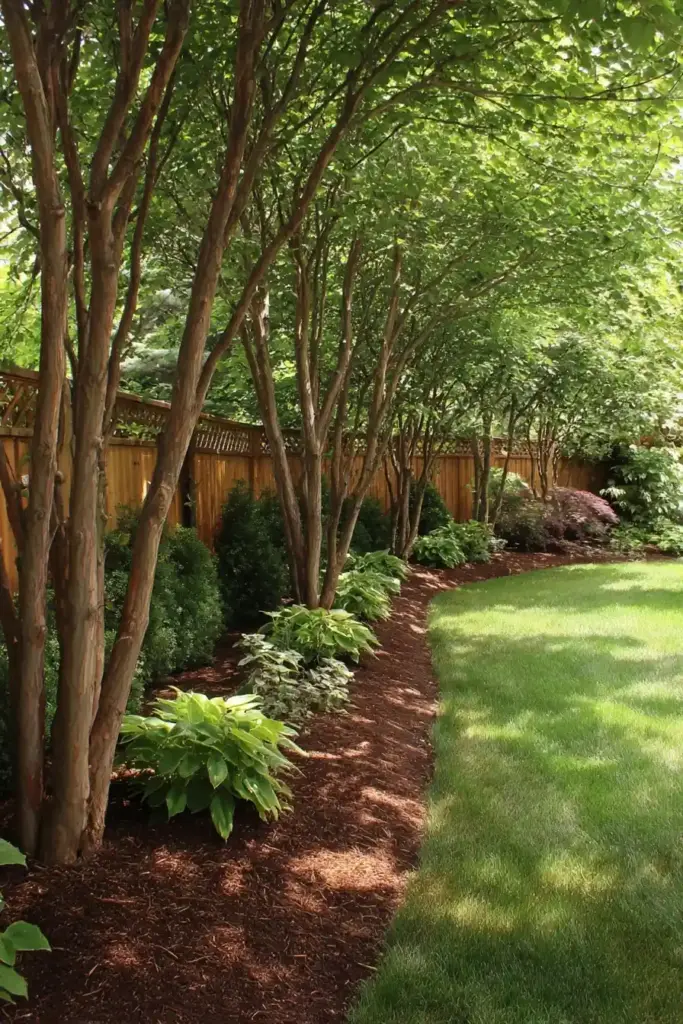
Combining privacy trees along a fence with well-maintained mulch beds is a simple yet powerful way to enhance both function and aesthetics. Mulch helps retain soil moisture, suppresses weeds, and gives your tree line a clean, polished appearance. It’s also incredibly low-maintenance—ideal for busy homeowners who want results without constant upkeep.
Start by planting your preferred privacy trees—Thuja, privet, or bamboo are all great options. Then, spread a 2–4 inch layer of organic mulch like shredded bark, pine straw, or wood chips around the base of each tree. Be sure to keep mulch a few inches away from the trunk to avoid rot and pests.
Why it Works:
- Improves tree health by regulating soil temperature and moisture
- Deters weeds and reduces mowing needs near the fence
- Creates a neat, cohesive look throughout the landscape
Tips for Success:
- Refresh mulch annually to maintain effectiveness and appearance
- Use edging (stone, metal, or plastic) to define mulch areas
- Consider adding decorative rocks or groundcovers for variety
A mulch bed not only improves your trees’ long-term vitality but also helps tie your privacy landscaping together into a unified, garden-worthy design.
4. Raised Planter Beds for Privacy
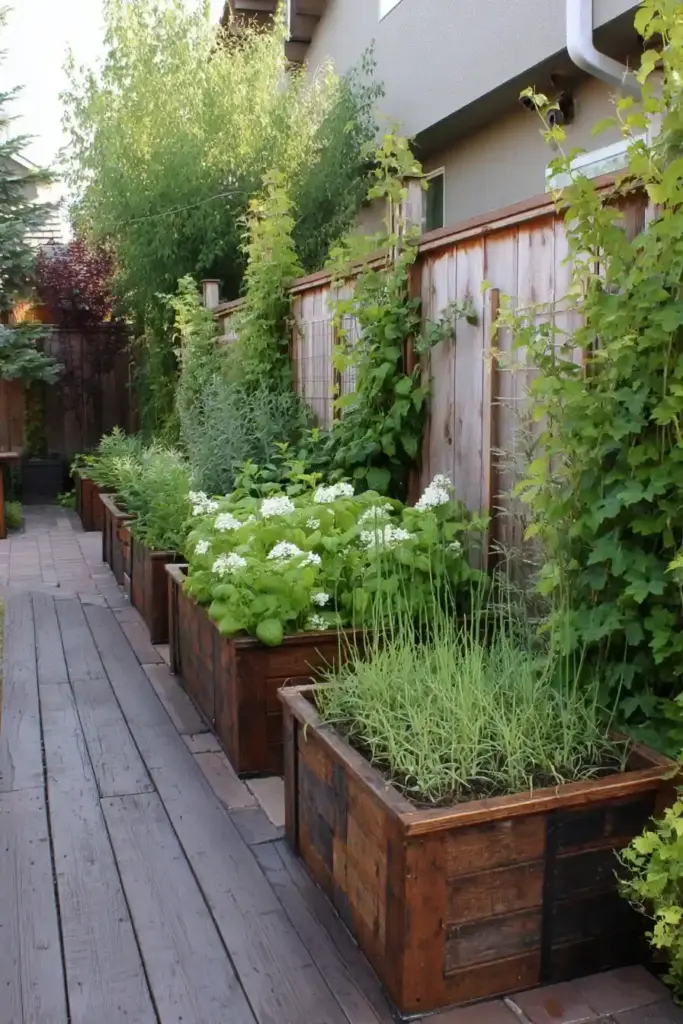
If your yard has poor soil, drainage issues, or simply needs a design upgrade, raised planter beds are an excellent way to grow privacy trees along a fence with style and structure. These elevated planting areas can be built using stone, brick, timber, or even modern composite materials to match your landscape’s aesthetic.
Raised beds allow you to control the soil quality and ensure proper root development for trees like dwarf conifers, Italian cypress, or columnar hornbeam. You can even include flowering shrubs or trailing plants like creeping thyme or alyssum around the edges for added beauty.
Why it Works:
- Improves drainage and soil quality for tree health
- Adds visual height and interest to flat landscapes
- Creates a more formal, intentional look along fence lines
Tips for Success:
- Build beds at least 18–24 inches deep for tree root growth
- Line the bottom with landscape fabric for weed control
- Add a drip irrigation system to simplify watering
Raised beds are especially useful in narrow side yards or urban gardens where soil conditions may be less than ideal but privacy is still a top priority.
5. Tree-and-Trellis Combo
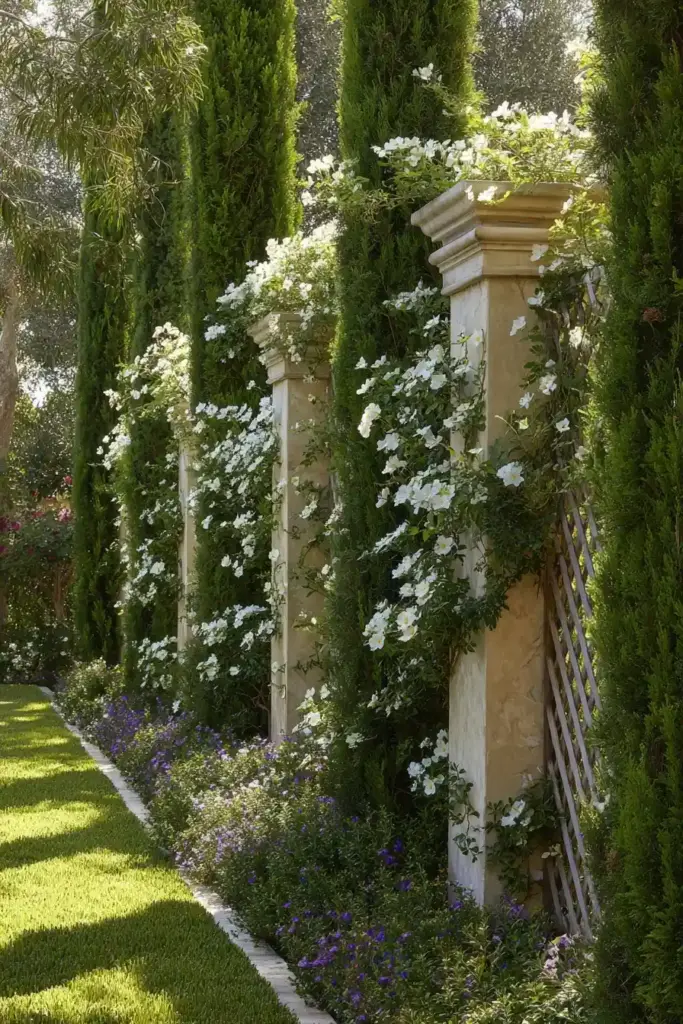
For narrow spaces or when you want fast, full coverage, a tree-and-trellis combo is a clever and elegant solution. This approach pairs fast-growing privacy trees with trellises or lattice panels, allowing you to mix vertical greenery with climbing plants for double the privacy—and double the beauty.
Start by planting upright, columnar trees like Italian Cypress, Skyrocket Juniper, or Emerald Green Arborvitae along the fence line. Then, install a trellis or decorative screen directly behind or in between the trees. Plant vigorous climbers like clematis, honeysuckle, or star jasmine to grow upward and fill the gaps while your trees mature.
Why it Works:
- Provides instant coverage, even before trees fully mature
- Adds vertical interest and texture to your fence line
- Offers seasonal color and fragrance from flowering vines
Tips for Success:
- Use rust-resistant or pressure-treated trellis materials
- Choose vines that won’t overwhelm young trees
- Space trees and trellises to allow airflow and growth
This hybrid privacy solution is perfect for creating a lush, layered look in smaller yards or where fences alone aren’t quite enough. It blends form and function beautifully—while staying rooted in natural charm.
6. Gravel Base Tree Rows
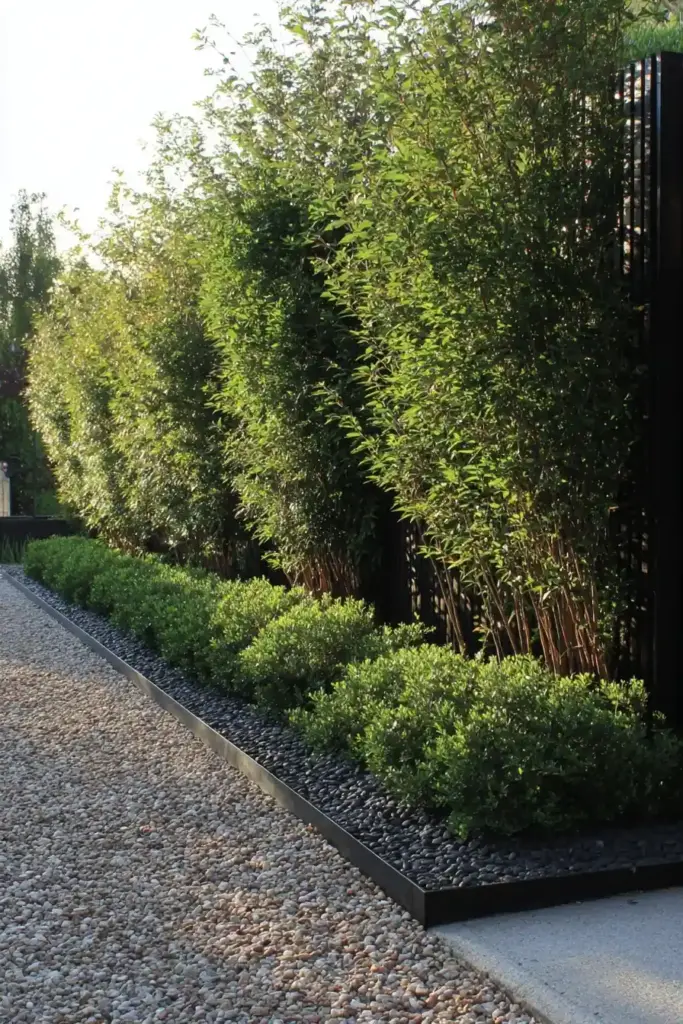
If you’re aiming for a sleek, low-maintenance look, planting privacy trees along a fence with a gravel base is a modern and practical choice. Gravel not only creates a crisp, tidy visual line—it also helps with drainage, suppresses weeds, and reduces mud splash around the base of your trees.
This method works particularly well with clean-lined privacy trees like hornbeam, columnar oak, or bamboo. After planting, lay landscape fabric to block weeds, then cover the area with decorative gravel such as pea gravel, crushed granite, or river rock. Add steel or stone edging to keep everything in place.
Why it Works:
- Enhances modern or minimalist landscapes
- Keeps root zones dry and weed-free
- Provides a striking contrast with green foliage
Tips for Success:
- Choose gravel colors that complement your home and fence
- Avoid piling gravel against tree trunks—leave a clear space
- Consider adding paver stepping stones between trees for function and design
Gravel beds around your privacy trees not only elevate the aesthetics of your fence line but also keep maintenance to a minimum—ideal for busy households or contemporary garden styles.
7. Privacy Trees with Underplanting
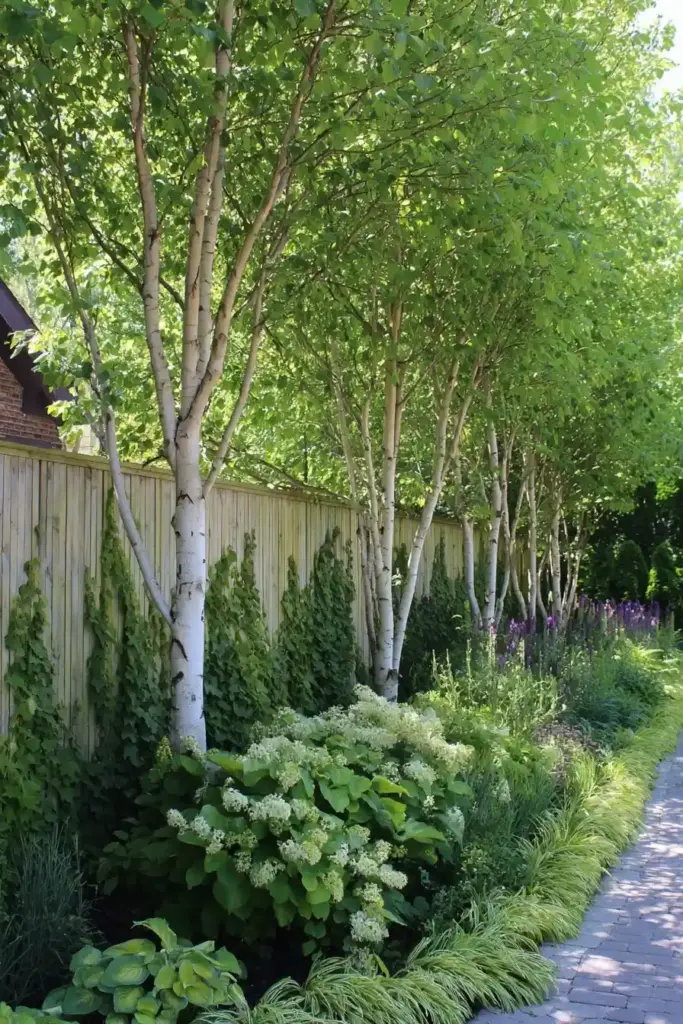
Want to take your tree line from simple to stunning? Try underplanting your privacy trees with shade-tolerant or complementary plants. This layered landscaping technique softens the base of trees and fills in empty ground, creating a fuller, more intentional garden design along your fence.
Start with sturdy, upright trees like Thuja, hornbeam, or juniper as your primary screen. Then, add plants such as hostas, hydrangeas, Japanese forest grass, or hellebores at the base. For color contrast, incorporate heuchera or coral bells. In sunny areas, you can use salvia, lavender, or daylilies instead.
Why it Works:
- Creates visual depth and texture beneath privacy trees
- Reduces soil erosion and helps retain moisture
- Attracts pollinators and increases garden biodiversity
Tips for Success:
- Choose underplants based on light conditions beneath your tree canopy
- Mulch between plants to conserve water and suppress weeds
- Space plantings to allow for growth and airflow
This technique turns a row of privacy trees along a fence into a rich, multi-layered garden bed that looks lush and curated all year long.
8. Ornamental Grass & Privacy Trees Mix
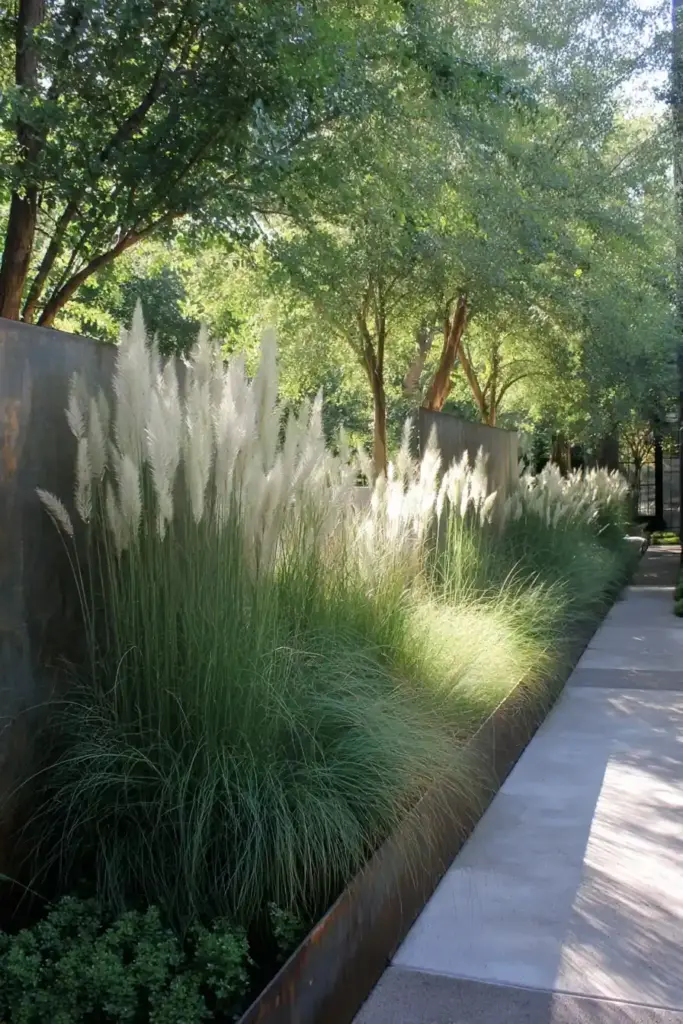
Pairing privacy trees along a fence with ornamental grasses brings movement, texture, and a soft contrast to structured evergreens or hedging trees. It’s a dynamic combination that looks just as good in the winter as it does during the growing season, especially when grasses sway in the breeze or catch the frost.
Start with vertical privacy trees like Leyland Cypress, columnar hornbeam, or Nellie Stevens holly. In front or between these trees, plant low-maintenance grasses like fountain grass, feather reed grass, or switchgrass. Their wispy blades and plumes add lightness and break up the solid green of tree foliage.
Why it Works:
- Adds movement and seasonal interest
- Softens the base of formal hedging trees
- Creates a layered, naturalistic privacy screen
Tips for Success:
- Choose grass species suited to your climate and sunlight
- Cut grasses back in late winter to encourage fresh spring growth
- Plant in groups or flowing curves for a more organic look
This mix brings balance to a tree-heavy border and is perfect for modern, meadow-inspired, or low-water landscapes where beauty and privacy go hand in hand.
9. Log or Stone Edging Along Tree Lines
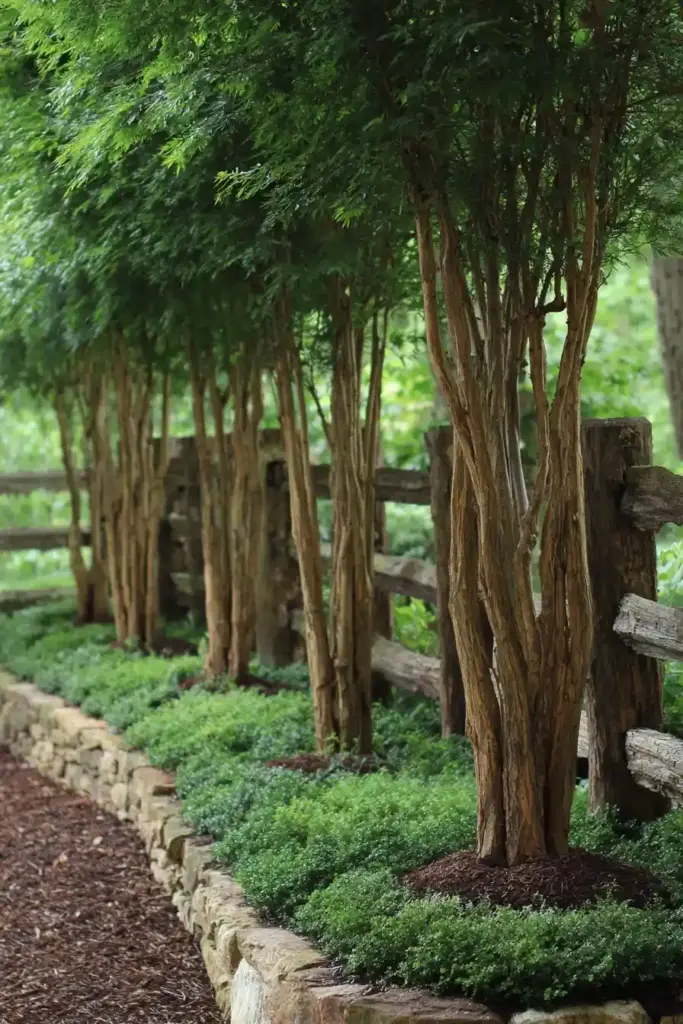
Give your privacy trees along a fence a clean, finished look by defining the planting area with log or stone edging. This simple design upgrade not only adds a touch of rustic charm or structured elegance but also helps keep mulch, gravel, or soil neatly contained around your tree bases.
For a natural, woodland aesthetic, use short logs, cut tree stumps, or split timber to create a border around your privacy tree row. If you prefer a more polished or modern look, go with flat landscaping stones, fieldstone, or brick pavers laid end-to-end. Edging also makes mowing and maintenance easier by establishing a clear boundary.
Why it Works:
- Defines tree beds and prevents soil/mulch washout
- Adds texture and contrast at the ground level
- Enhances the visual structure of long fence lines
Tips for Success:
- Bury edging slightly for stability and clean lines
- Use treated or rot-resistant materials if placing wood directly on soil
- Pair with underplanting or mulch for a layered effect
Edging is a small detail that makes a big visual impact—and it helps turn a simple row of privacy trees into a cohesive, landscaped border.
10. Colorful Autumn Screening Trees
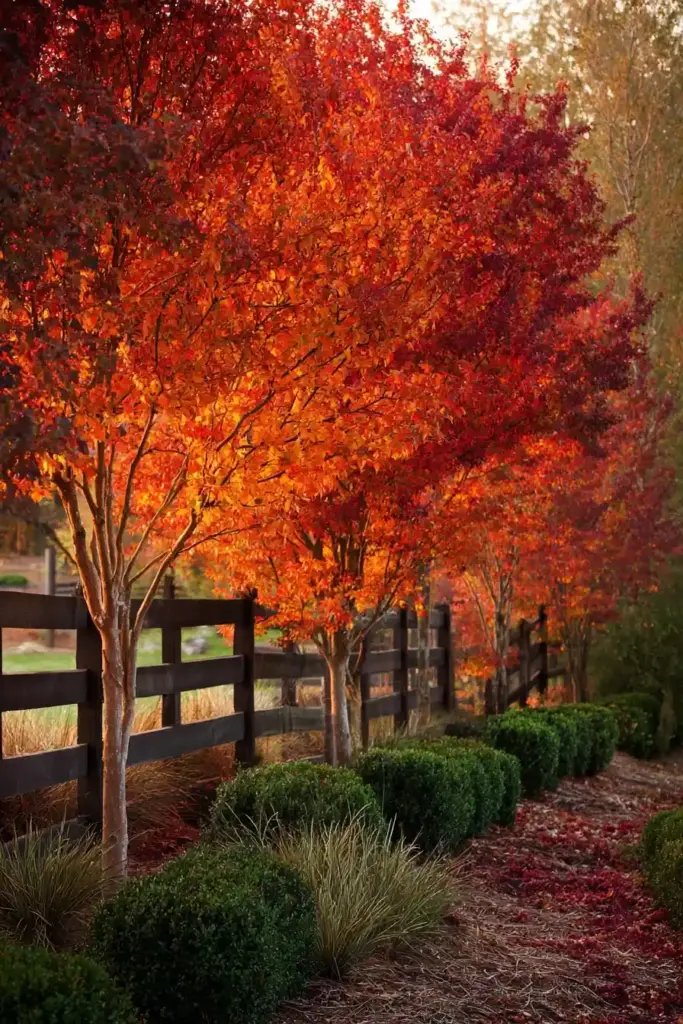
If you’re looking to blend privacy with seasonal beauty, autumn screening trees are a stunning choice. These deciduous privacy trees provide full coverage during the growing season and reward you with brilliant foliage in the fall—adding drama and warmth to your fence line just when the rest of the garden starts to fade.
Consider trees like Serviceberry, Red Maple, Sweetgum, or Amur Maple. They grow densely enough to form a visual barrier and bring vibrant shades of red, orange, and gold when autumn arrives. To maintain year-round privacy, you can interplant them with narrow evergreens like Eastern Arborvitae or Boxwood shrubs.
Why it Works:
- Provides seasonal color while still offering privacy
- Enhances fall curb appeal and landscape interest
- Blends beautifully with naturalistic or woodland garden styles
Tips for Success:
- Choose species with strong fall color and upright growth
- Space trees to account for their mature width and leaf drop
- Mulch beneath for easier leaf cleanup and root health
This approach proves that privacy trees along a fence don’t have to be all green, all the time—they can also celebrate the changing seasons with bold, beautiful foliage.
11. Tree Fence Alcoves for Seating
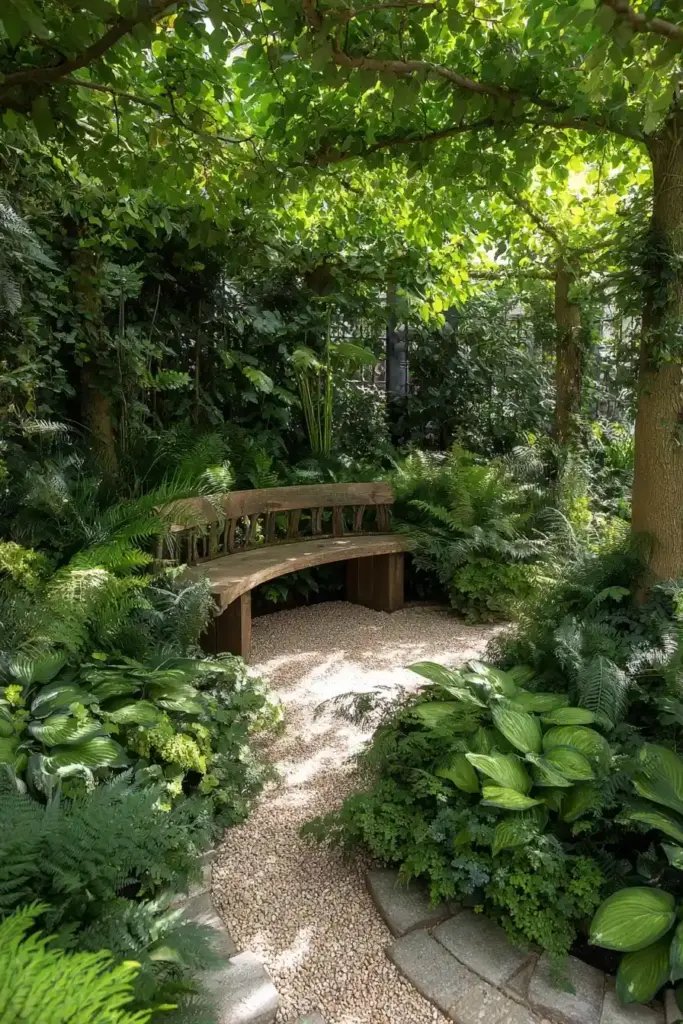
Why not turn your privacy trees along a fence into more than just a screen? By thoughtfully spacing your trees, you can create natural alcoves for seating—cozy, shaded nooks perfect for reading, relaxing, or enjoying a morning coffee outdoors. These intimate garden zones feel both private and inviting.
Start by planting small clusters or semi-circles of trees like hornbeam, Arborvitae, or Holly at intervals along the fence. In between these groupings, tuck in a bench, swing seat, or even a small bistro set. Add underplanting like ferns or hostas, and you’ll have a peaceful escape built right into your fence line.
Why it Works:
- Turns privacy landscaping into functional outdoor living space
- Offers quiet, shaded spots to unwind or entertain
- Breaks up long fence runs with visual and spatial variety
Tips for Success:
- Ensure trees have enough space to grow without crowding seating areas
- Use gravel, mulch, or pavers under benches for easy upkeep
- Add solar lights or lanterns to enhance nighttime ambiance
Tree alcoves elevate your yard from purely practical to deeply personal—proof that privacy doesn’t have to come at the cost of comfort or charm.
12. Staggered Tree Heights for Dimension
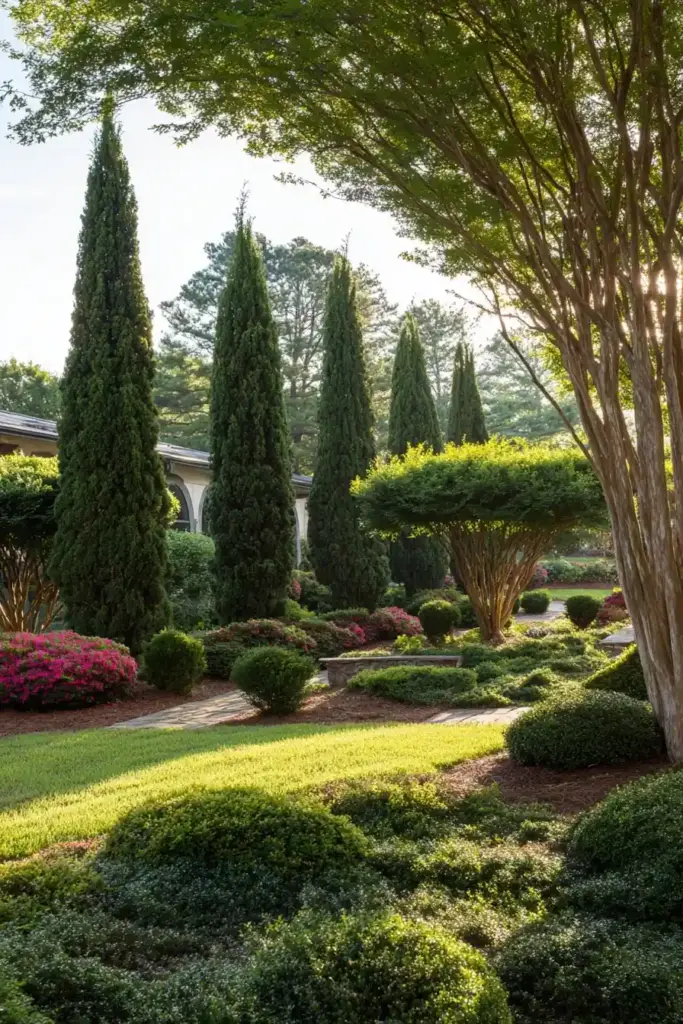
A straight row of identical trees can feel a bit rigid or one-dimensional—but by using staggered tree heights, you can create a fence line that feels dynamic, layered, and more like a natural landscape. This approach involves planting trees of varying heights in front of and behind each other, giving your privacy screen a lush, three-dimensional look.
For example, use tall trees like Leyland Cypress or Nuttall Oak as a backdrop, and stagger medium-sized trees such as crape myrtle, cherry laurel, or ornamental pear in front. Add small trees or shrubs like boxwood, azaleas, or spirea at the base to complete the effect.
Why it Works:
- Adds depth and movement to your privacy planting
- Softens harsh fence lines with a layered garden feel
- Mimics natural forest edges for a more organic look
Tips for Success:
- Plant in triangular groupings or loose clusters—not straight lines
- Use color and texture contrasts between foliage types
- Maintain spacing to allow for airflow and long-term growth
A staggered height approach brings your privacy trees along a fence to life—turning a static screen into a vibrant, ever-changing backdrop.
13. Companion Planting With Fruit Trees
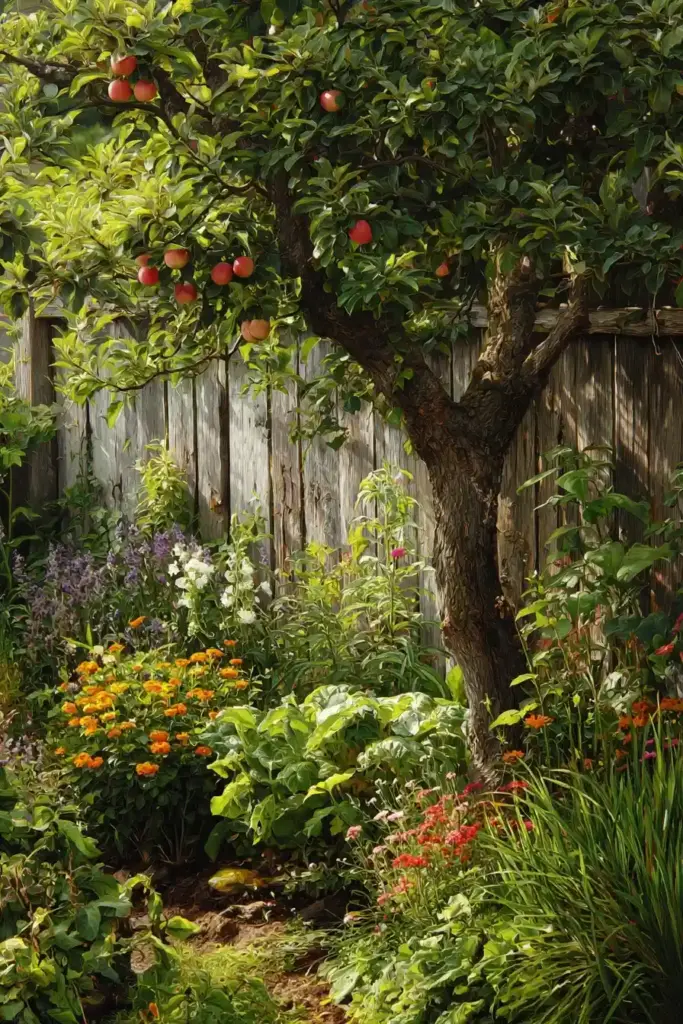
Looking for privacy with a side of productivity? Try using fruit trees as privacy trees along your fence—and enhance their growth and pest resistance with companion planting. This strategy not only adds seasonal interest and delicious yields, but also supports a healthy, biodiverse garden.
Fruit trees like apple, plum, or cherry can be trained along a fence in espalier form or allowed to grow more naturally in rows. Beneath them, plant beneficial companions like lavender, chives, marigolds, or nasturtiums—all of which deter pests and attract pollinators.
Why it Works:
- Fruit trees provide seasonal screening and edible rewards
- Companion plants enhance pollination and reduce the need for chemicals
- Creates a multi-purpose privacy solution with garden-to-table benefits
Tips for Success:
- Choose fruit varieties suited to your climate and fence orientation (sunlight)
- Prune annually to manage shape, airflow, and harvest
- Use mulch or ground covers to reduce weeds and retain soil moisture
By combining privacy and productivity, this method turns your fence line into a living pantry—beautiful, functional, and sustainable.
14. Year-Round Privacy with Mixed Species
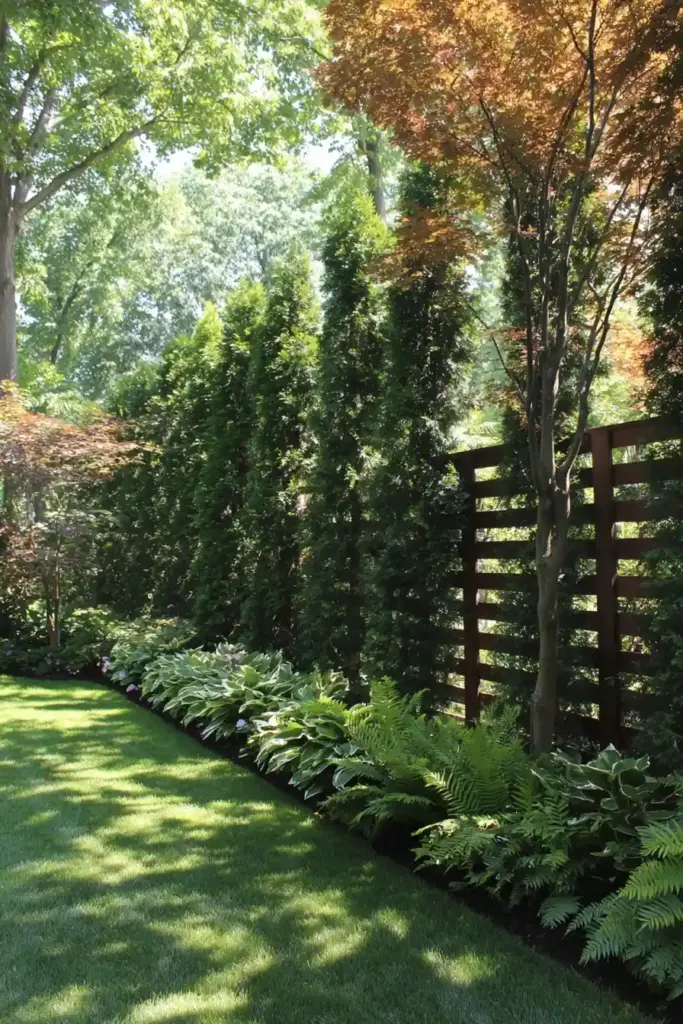
For reliable privacy in every season, consider planting a mix of evergreen and deciduous trees along your fence. This ensures that your screen remains effective all year, even as some trees lose their leaves in fall and winter. A mixed-species privacy screen also offers greater resilience against pests, diseases, and climate fluctuations.
Start with structural evergreens like Eastern Red Cedar, Arborvitae, or Holly to maintain full coverage in colder months. Interplant with deciduous trees such as Serviceberry, Dogwood, or Tulip Tree for seasonal interest and color. The result is a visually engaging, functional barrier that adapts and thrives through the seasons.
Why it Works:
- Ensures continuous privacy while adding seasonal variety
- Enhances biodiversity and reduces risk of uniform plant failure
- Creates a natural, layered look along your fence line
Tips for Success:
- Select trees with similar water and light needs for easier care
- Alternate species in a loose, informal pattern for a natural look
- Use underplantings like ferns or grasses to tie the design together
This approach balances the year-round screening power of evergreens with the changing beauty of flowering and foliage-rich deciduous trees—a perfect harmony of form and function.
15. Backyard Retreat with Enclosed Tree Bed
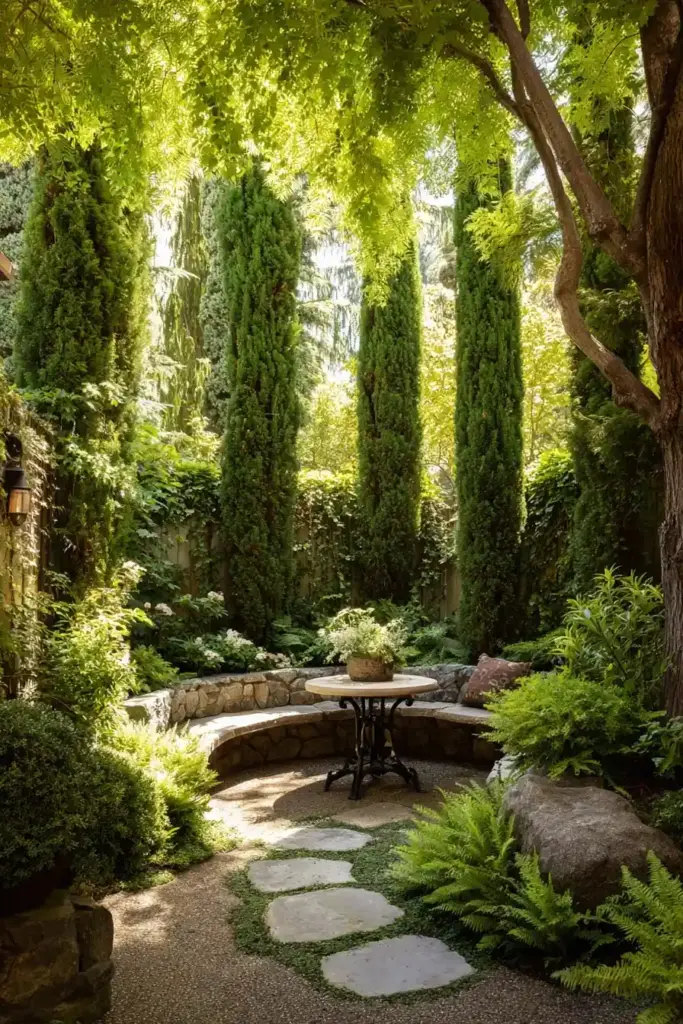
Transform your fence line into a private backyard retreat by creating an enclosed tree bed—a defined space where privacy trees form a natural room or garden sanctuary. This technique combines strategic tree placement with thoughtful hardscaping to carve out a peaceful escape right along the edge of your property.
Use tall, narrow trees like Italian Cypress, Hornbeam, or Thuja ‘Emerald Green’ to form a semi-enclosed wall. Then define the space with a curved or rectangular bed made from stone, brick, or wooden edging. Add stepping stones, groundcovers, and even a small bistro table or bench inside the space to make it functional and serene.
Why it Works:
- Creates a sense of enclosure and intimacy
- Turns a plain fence line into a destination within the yard
- Offers privacy while feeling integrated with the landscape
Tips for Success:
- Keep spacing consistent for balance and symmetry
- Layer with mulch, ferns, or seasonal flowers for softness
- Add lighting or water features for ambiance
This final idea transforms your privacy trees along a fence into more than just a border—they become the foundation for a personal hideaway, blending beauty, function, and tranquility.
Frequently Asked Questions (FAQ)
🌲 What are the best privacy trees to plant along a fence?
Some of the best privacy trees include Thuja Green Giant, Leyland Cypress, Emerald Green Arborvitae, Hornbeam, and Eastern Red Cedar. These trees grow densely, offer year-round coverage, and are relatively low-maintenance. You can find more ideas in our guide on privacy trees along a fence.
🌞 Do privacy trees need full sun to grow well?
Many privacy trees thrive in full sun (6+ hours), but there are shade-tolerant options like American Holly, Yew, and Skip Laurel that grow well in partial shade. If you’re working with low-light conditions, check out our list of shade-loving perennials.
📏 How far apart should I plant privacy trees along a fence?
Spacing depends on the species and its mature size. In general, space trees 3 to 8 feet apart to balance coverage with airflow. For a faster screen, closer planting works, but ensure there’s enough room for healthy root development and maintenance.
🧱 Can I plant privacy trees near a neighbor’s fence?
Yes—but always be respectful of property lines and aware of the tree’s eventual size. For tight spots, try narrow growers like Sky Pencil Holly or Italian Cypress. You can also explore creative small yard landscaping ideas for more inspiration.
🪵 What can I plant under privacy trees?
Excellent underplanting choices include hostas, ferns, heuchera, hydrangeas, and ornamental grasses. These shade-tolerant plants add texture and color below your trees. Browse our list of drought-tolerant plants to select low-maintenance varieties.
🌧️ How do I maintain privacy trees?
Key steps include deep watering during dry periods, annual pruning to control shape, mulching to retain moisture, and checking regularly for pests or diseases. For a quick overview of effective mulching methods, visit our cedar mulch landscaping ideas.
Conclusion
Landscaping with privacy trees along a fence offers more than just seclusion—it brings structure, beauty, and seasonal charm to your outdoor space. Whether you’re aiming for a cozy garden retreat, a modern landscape design, or a lush natural barrier, the ideas above prove that privacy and style can grow hand in hand.
With proper planning, diverse plantings, and thoughtful touches like underplanting with drought-tolerant perennials or defining spaces with mulch and edging, you can transform your fence line into one of your landscape’s most beautiful and functional features.
🌿 Love gardening inspiration? Follow me on Pinterest for bold plant ideas, tips, and seasonal color!
More Posts
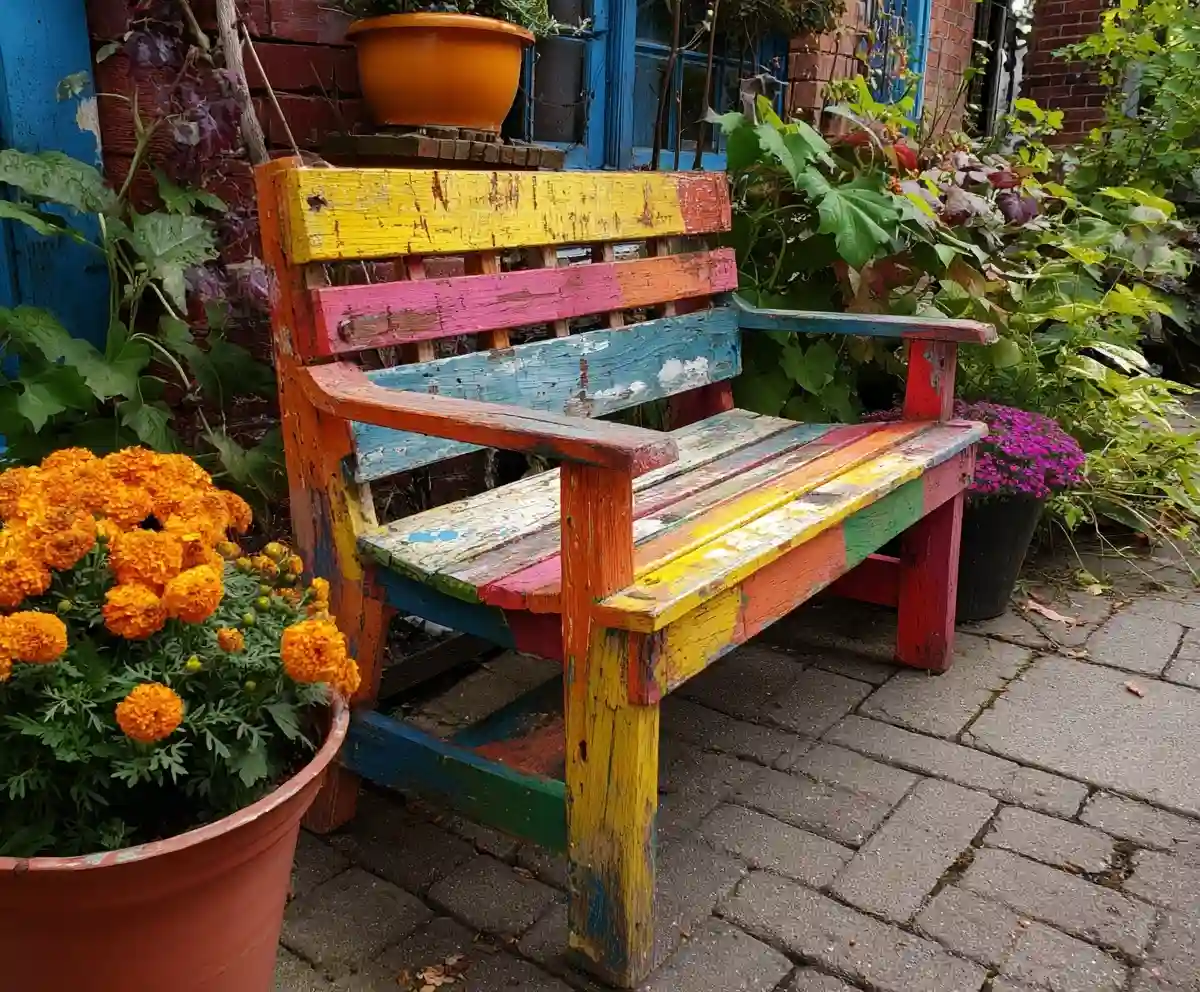
19+ Budget-Friendly Backyard Makeover Ideas
Backyard makeover ideas can turn even the most ordinary outdoor space into a warm, inviting retreat—without draining your wallet.
Read More →
21 Stunning & Simple DIY Clematis Trellis Designs
DIY clematis trellis designs are a beautiful way to blend creativity with function in your garden.
Read More →
12 Full Sun Perennials That Bloom All Summer
Explore a selection of hardy perennials that flourish and bloom beautifully in full sun throughout the summer.
Read More →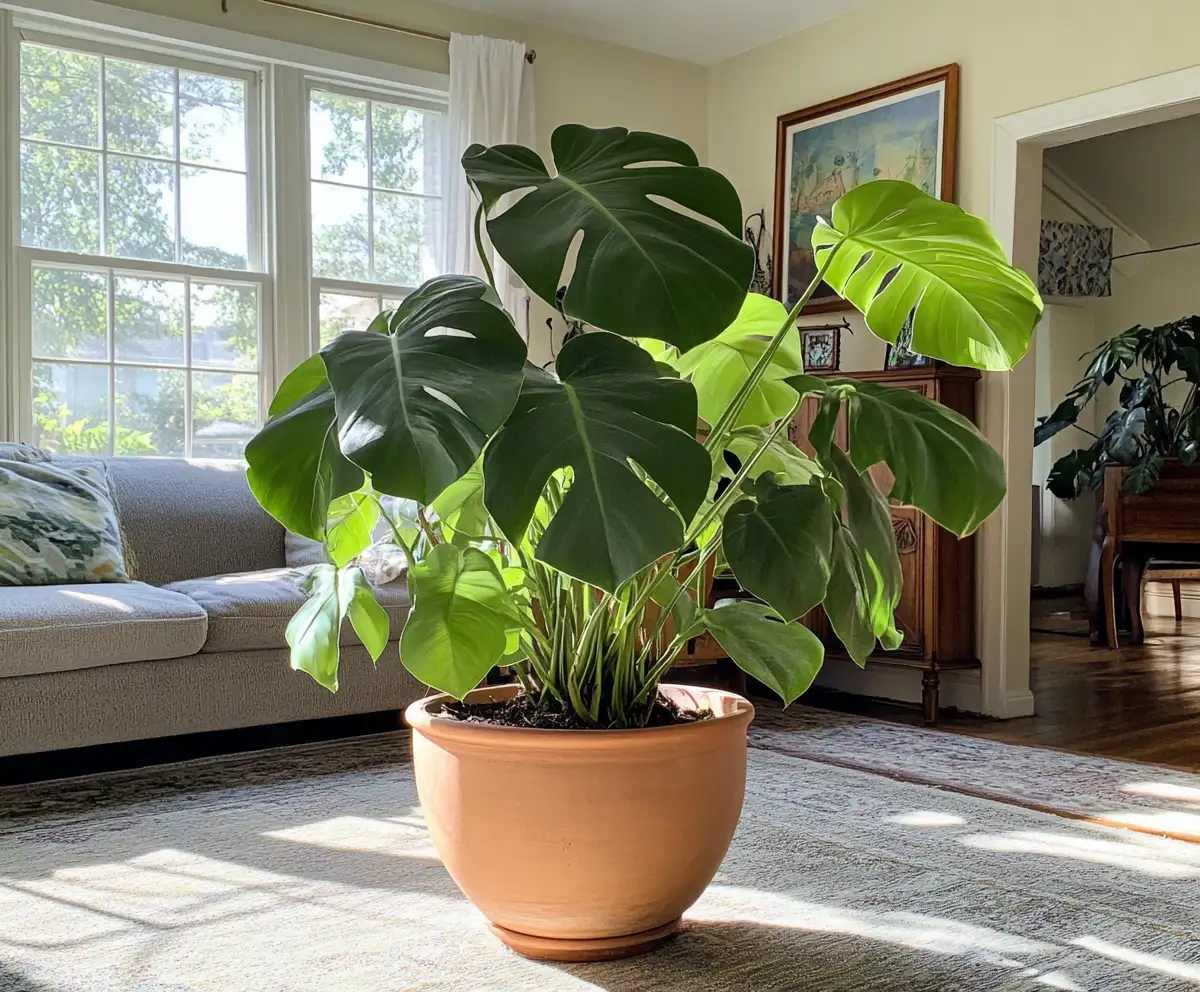
Houseplants for Living Room
Find the perfect houseplants to brighten and purify your living room while adding a touch of nature indoors.
Read More →
Backyard Play Area for Kids
Create a fun and safe backyard play area for kids with these inspiring design ideas and tips.
Read More →
Top Privacy Trees
Discover top tree varieties that provide natural privacy and enhance your outdoor space.
Read More →
